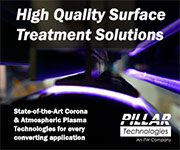SUBSTRATES REPORT: From Resins to Finished Product - Conformability, Durability, Affordability
- Published: July 01, 2001, By Dave Constantine, Senior Product Chemist, FLEXcon
In an industry faced with ever-increasing production costs and corporate consolidation, the demand for competitively priced substrates has never been higher.
At the same time, labeling and packaging requirements continue to grow. OEMs and end-users are demanding substrates that will conform and adhere to an increasing variety of shapes and materials.
And, they want materials that are as esthetically pleasing as they are functional.
Indicators suggest that demand for most substrates will continue to grow. The use of PE, which 15 years ago was expected to capture a significant portion of vinyl's market share, has expanded, but not at the expected rates. PP continues to make significant advancements, as does vinyl. In fact, the need to move substrate use into new and emerging markets has inspired some suppliers to enhance existing strengths and develop new ones.
PP Uses are Evolving
During the last ten years, biaxial PP has found significant growth in the clear no-label-look on glass bottles, making it a commodity staple among packagers. PP offers good printability, die-cuttability, and overall clarity, making it an economical alternative to polyester, especially in the packaging arena.
Today, as the glass bottle market continues to evolve, more marketing emphasis is being put on packaging, particularly in the increasingly crowded wine and “new-age” beverage markets. Some products have attempted to distinguish themselves by utilizing contoured bottles with more complex curves. As a result, substrate manufacturers are developing mono-axial versions of PP that will provide more conformability than its biaxial counterpart, while also offering excellent dispensing characteristics.
Engineers also are working to counter PP's inherent low surface energy, which can create significant printing challenges. The problem traditionally has been handled with topcoatings, but new efforts are underway to develop nontopcoated print treatments in PP's chemical compounding. If successful, it may help make PP more competitive with some paper stocks.
Vinyl Big in Large Formats
The market for vinyl has almost doubled over the past ten years, with most of the growth emerging from the wide-format sector, mainly large graphic displays, transit advertising, bus wraps, and fleet graphics.
Although vinyl has always been known for its durability, these end uses have substrate manufacturers developing vinyls that are more flexible and printable via new print technologies. In particular, solvent ink jet has emerged as a very economical method for producing computer-generated, large-format products. These new markets require superior die-cuttability, print adhesion, and ease of application.
Meeting the demands of the market, advancements in adhesive technology have provided products that can be applied, reworked, and, ultimately, removed easily at the end of the product's life cycle. Substrate engineers also are working to develop vinyls that will feature better surface energy retention, enhancing printability.
Although large-format vinyl applications often involve flat surface areas, more opportunities are emerging that require conformance to corners, rivet heads, and irregularly shaped surfaces. As a result, the substrate industry has been asked to provide higher quality plasticizers.
This flexibility also is critical when graphic application or removal takes place during winter months. In cold conditions, vinyl tends to become brittle, resulting in “cold crack.” This can hamper the removal of old graphics. Substrate manufacturers hope to combat cold crack with additives that will help vinyl retain its flexibility, even at lower temperatures.
Polyester Meeting the Challenge
Polyester manufacturers have been experiencing significant capacity issues due to reduced demand for magnetic tape as DVDs and CDs expand their market dominance. The challenge has been to add value, making polyester more functional for a broader range of markets.
These efforts have begun to pay off. This substrate has experienced growth in the durable markings sector because of its ability to resist chemicals, abrasion, and harsh environments.
In particular, there have been significant increases in demand in the outdoor power tool, lawn and garden, and automotive labeling markets. Here, UL and CSA requirements have necessitated a chemically resistant film that remains legible for the long term.
Interior applications, such as for nameplates and membrane switches, also have posted substantial gains.
One of polyester's drawbacks is its inability to withstand ultraviolet light, making it impractical for applications that require long-term outdoor durability. In an effort to achieve enhanced durability, polyester suppliers are developing more stable polyesters, some of which feature UV blockers as part of their composition. This may result in slight to moderate cost increases, but there will be a significant enhancement to the overall value.
PE and its Benefits
While PP has captured significant market share as a result of its lower cost, PE remains an important substrate, especially in the packaging sector.
One of PE's most valuable characteristics is its surface consistency, which allows converters to print and die-cut without fear of product variation. It has evolved into a gel-free form that allows substrate manufacturers to create different gloss and haze levels, as well as gauges. Polyethylene remains very easy to topcoat and is generally easy to die-cut.
PE remains flexible when exposed to cold temperatures, but it is not as durable as vinyl. Engineers are working on enhancing the product's UV resistance in an effort to make it a more attractive alternative to vinyl.
Ultimately, market forces will drive the evolution of these individual substrates. Conformability, durability, and affordability remain, as ever, the characteristics that end-users need and want.













